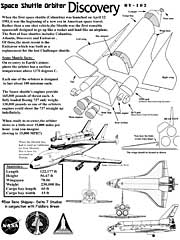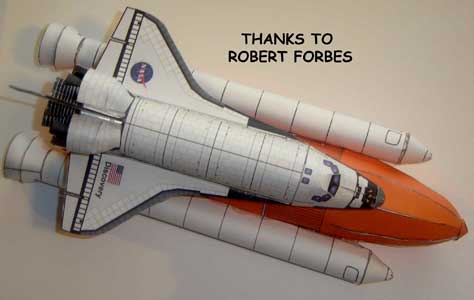


Free Model: Space Shuttle - Discovery/Enterprise


Discovery, the third orbiter to become operational at Kennedy Space Center, was named after one of two ships that were used by the British explorer James Cook in the 1770s during voyages in the South Pacific that led to the discovery of the Hawaiian Islands. Another of his ships was the Endeavor, the namesake of NASA's newest orbiter.
Cook also used Discovery to explore the coasts of southern Alaska and northwestern Canada. During the American Revolutionary War, Benjamin Franklin made a safe conduct request for the British vessel because of the scientific importance of its research.
Other famous ships have carried the name Discovery, including one used by Henry Hudson to explore Hudson Bay in Canada as well as search for what was hoped to be the northwest passage from the Atlantic to the Pacific in 1610 and 1611. Another, based on whaling ship design, was used by the British Royal Geographical Society for an expedition to the North Pole in 1875.
This organization then built another Discovery in 1901 to conduct its Antarctic expedition that concluded in 1904. This ship still exists and is being preserved by the Society.
In the day-to-day world of Shuttle operations and processing, Space Shuttle orbiters go by a more prosaic designation. Discovery is commonly referred to as OV-103, for Orbiter Vehicle-103. Empty Weight was 151,419 lbs at rollout and 171,000 lbs with main engines installed.
The Space Shuttle Columbia is being offered
as a free download at the Delta 7 site:
http://www.delta7studios.com
Whoa Rocketman!....What a job on the Shuttle (or Orbiter or whatever ...). You've done a real bang-up job of designing a beautiful model that captures the spirit and essence of the real thing and managed to keep it easy-to-build and not fiddly. Chauncy Green, (Feb 23, 01)
The nose on the shuttle came out perfect. I used the tissue paper in the back method and It just shaped itself. Matt Sparks (Feb 01)
I am a BAR (born again rocketeer) That was my original introduction to paper modeling, my first rocket was back in 1974, a Centuri X-24 bug which was a paper model with a rocket engine in it. Centuri is out of business but you can download the model from the web and re-create it. I am working hard to convert several of Dan's Models to fly as model rockets. While building Dan's Beta Discovery, I realized it was close to the same scale as the old Estes Space shuttle. ...a great rocket model but the "orbiter" was a vacuformed nightmare. I ended up postholing mine one day when the flaperons failed to deploy and it came down as fast and as straight as it went up. I have been looking for a replacement shuttle. Dan's seemed to fit the bill. Matt Sparks (Feb 01)
My son and I were fortunate enough to get to beta this model and I can only say that Dan has once again out done himself. We were simply amazed every time he would send us something to build up for him. It is a nice thought to think that someday we may see an astronaut in an interview state that it all began when he or she was a child with a one of his models, a pair of scissors, and a bottle of glue. Thanks Dan for a job well done..God Speed -John Watterson (Feb 28)
Your models of the refurbished Discovery and the refubished
Columbia are really well done. It took a lot of time to
assemble these models.
I am certain that it took a lot of time to have these graphically
designed as well. Now I understand why you guys do this
for money.
And I am pleased to pay for these. Thomas O'Brien (7/03)


This is a little dated study of Dan's Space Shuttle model under development.. To produce a 'simple' model takes much more planning and thought than you would expect.
NASA - Space Shuttles

Discovery benefited from lessons learned in the construction and testing of Enterprise, Columbia and Challenger. At rollout, its weight was some 6,870 pounds less than Columbia. Two orbiters, Challenger and Discovery, were modified at KSC to enable them to carry the Centaur upper stage in the payload bay. These modifications included extra plumbing to load and vent Centaur's cryogenic (L02/LH2) propellants (other IUS/PAM upper stages use solid propellants), and controls on the aft flight deck for loading and monitoring the Centaur stage. No Centaur flight was ever flown and after the loss of Challenger it was decided that the risk was too great to launch a shuttle with a fueled Centaur upper stage in the payload bay.
These modifications included extra plumbing to load and vent Centaur's cryogenic (L02/LH2) propellants (other IUS/PAM upper stages use solid propellants), and controls on the aft flight deck for loading and monitoring the Centaur stage. No Centaur flight was ever flown and after the loss of Challenger it was decided that the risk was too great to launch a shuttle with a fueled Centaur upper stage in the payload bay.
 |
The Names of the Space Shuttle Orbiters:
America's fleet of Space Shuttle orbiters are named after pioneering sea vessels which established new frontiers in research and exploration. NASA delved through the history books to find ships which achieved historical significance through discoveries about the world's oceans or the Earth itself. Another important criterion in the selection process was consideration for the international nature of the Space Shuttle program. The name of NASA's newest orbiter, Endeavor was selected from names submitted by school children around the world.
Atlantis is named for the primary research sailing vessel used by the Woods Hole Oceanographic Institute from 1930 to 1966 and was the first vessel to use electronic sounding devices to map the ocean floor.
The ill-fated Challenger was named for an American naval research vessel that sailed the oceans in the 1870s.

Discovery was named for one of the two ships used by the British explorer Captain James Cook when he discovered Hawaii and explored Alaska and northwestern Canada in the 1770s. It was also the name of one of Henry Hudson's ships that explored Hudson Bay in 1610-1611. Yet another ship named Discovery was used by the British Royal Geographical Society in 1875 to explore the region of the North Pole, and yet another was built by the Society in 1901 to explore the Antarctic regions. This last ship Discovery still exists.
The other of Cook's ships is the namesake for the Shuttle Endeavor. This ship was used in astronomical research, and its observations enabled the astronomers of the day to determine accurately, for the first time, the distance between the sun and the Earth. It was also noted as the ship that first explored New Zealand. Its voyages were the first long-distance sea voyages in which no crew members died of scurvy; Captain Cook forced the crew to eat a high vitamin C diet that prevented the disease.
Enterprise, the first Space Shuttle Orbiter, was originally to be named Constitution (in honor of the U.S. Constitution's Bicentennial). However, viewers of the popular TV Science Fiction show Star Trek started a write-in campaign urging the White House to rename the vehicle to Enterprise.



Specifications for the Space Shuttle
 |
Length System: 84.2 ft Orbiter: 122.2 ft Height System: 76.6 ft Orbiter: 56.67 ft Wingspan Orbiter: 78.06 ft Weight Gross Lift-0ff: 4.5 million lb Orbiter Landing: 233,000 lb Thrust Solid Rocket Boosters (2): 3.3 million lb of thrust each at sea level Orbiter Main Engines (3): 394,000 lb of thrust each at sea level Payload Bay Dimensions: 60 ft long, 15 ft in diameter Accommodations: Payloads ranging from Getaway Specials to deployable/retrievable spacecraft to equipped scientific labs Capability Maximum payload: 55,000 lb Up to 12 flights per year Satellite recovery, service, return |
 |
The space shuttle Challenger explodes shortly after lifting off from Kennedy Space Center on Jan. 28, 1986. All 7 astronauts were killed. |


